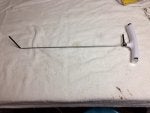One walmart digital luggage scale ($5.00 from the bargain bin. One wire from an abandoned political sign. One nut. One bolt. One piece of heat shrink tubing.
Cut the triangle ring off of gauge that left an eye hole that attaches to the scale. Cut off the proper length of wire from sign and bent one end in an L and covered, and heat shrunk, tubing over extended L. Bent other end into the same sized eye hole as the one on the scale. Put fitting bolt through and tightened with nut. From handle to end, very rigid and with rubber tubing, holds very well to get reading.
Tested on my new Timney trigger and came out as factory spec of just over 3 lbs. (3.07/3.08/3.07). Tested trigger with Cabela's trigger pull gauge (not digital) and got 3.08 lbs estimated). Only advantage to the store built is it at trigger break it meter stops at that point. With mine you have to pull slowly and watch the gauge for the break. I think mine is more accurate.
Total cost was $5.00 as I had the other stuff.
Going to cut off excess and put wing nut for easier storage.
What can I say. I like to tinker.
Cut the triangle ring off of gauge that left an eye hole that attaches to the scale. Cut off the proper length of wire from sign and bent one end in an L and covered, and heat shrunk, tubing over extended L. Bent other end into the same sized eye hole as the one on the scale. Put fitting bolt through and tightened with nut. From handle to end, very rigid and with rubber tubing, holds very well to get reading.
Tested on my new Timney trigger and came out as factory spec of just over 3 lbs. (3.07/3.08/3.07). Tested trigger with Cabela's trigger pull gauge (not digital) and got 3.08 lbs estimated). Only advantage to the store built is it at trigger break it meter stops at that point. With mine you have to pull slowly and watch the gauge for the break. I think mine is more accurate.
Total cost was $5.00 as I had the other stuff.
Going to cut off excess and put wing nut for easier storage.
What can I say. I like to tinker.





